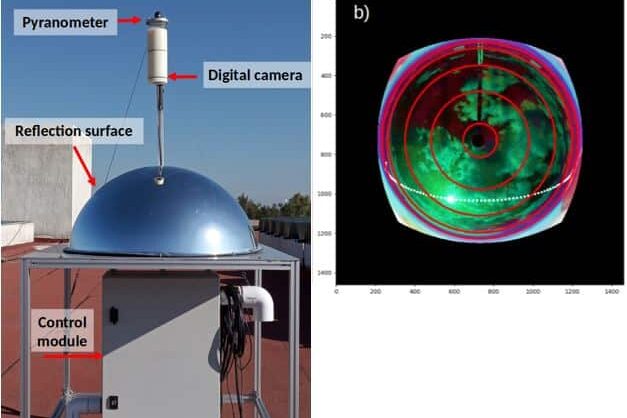The development of systems for harnessing Solar Energy has allowed society to migrate towards a more sustainable model of the planet. However, in order for this technology to become competitive and allow it to meet the humanity’s growing energy demand, it is still necessary to solve the great techno-economic challenges of solar technology.
In particular, the Solar Energy Research and Engineering Group (GIIE-Sol), of the Aguascalientes Unit of the Centro de Investigaciones en Óptica, A.C. (CIO) works on research, development and innovation (R+D+I) of solar thermal and photovoltaic systems to improve their competitiveness and provide solutions to heat and electricity needs in society and industry. In general terms, 7 key areas can be defined within the actions of the GIIE-Sol.
- Solar resource assessment.
- Optical and mechanical design.
- Component optimization.
- Instrumentation and control.
- Optical, thermal and electrical tests.
- Intelligent Systems.
- Solar thermal photovoltaic and photochemical applications.
Each of these areas generates great technical challenges that also provide enormous areas of opportunity. Mexico, being positioned in the so-called “solar belt” (Latitude: 23.5 ºN) is one of the most privileged areas for solar irradiance. It is estimated that in the semi-arid region of the Bajío an average of 5.5 kWh/m2 of solar irradiance reaches the ground from the sun, and in the desert areas north of the country can attract up to 6 kWh/m2 of solar irradiance!
Although solar energy is extremely abundant in Mexico, there are still few efforts to develop industrial systems that take advantage of it. I would like to delve into the solar thermal, photovoltaic and photocatalytic applications developed by the GIIE-Sol that represent a complementary effort with the scientific community to take advantage of the energy that the sun provides:
- The development of smart sensors as a means of quantifying solar irradiance using artificial vision methodologies has enormous advantages over traditional radiometers: Their low cost and their programming capacity make it possible to identify the dynamics of the sky, and predict the behavior of solar irradiance in short time horizons, “nowcasting.” This project is a multidisciplinary and inter-institutional effort including Daniel Sánchez (CIO Postgraduate), Manuel I. Peña Cruz (CIO-Ags Technical Manager), Luis Valentin (CIO-Ags), Arturo Díaz (CIO-Ags), Daniela Moctezuma (CentroGeo), Gerardo Flores (CIO -Leon), David Riveros (IG-UNAM).
- Derived from mature silicon cells, alternative semiconductor materials that provide greater energy conversion efficiency (electromagnetic-electric) continue to be investigated. There are already cells in commercial use (although limited), based on the union of multiple layers of Tandem or Multi-junction cells that make up a sort of semiconductor sandwich. These layers take advantage of certain wavelengths of the electromagnetic spectrum to convert sunlight into electrical energy with up to 40% efficiency. Although they require an investment in optical elements to take better advantage of solar radiation, they are a promising alternative that the GIIE-Sol investigates to reduce costs and make it commercially competitive. Project led by Arturo Diaz.
- The development of solar concentration systems that allow reaching average operating temperatures (100-300 ºC) to meet the needs of industry (solar process heat) is a topic of great interest to GIIE-Sol. That is why efforts have been made to link with the local industry, in particular with the company Inventive Power® (with 100% national capital), which allows improving the performance and robustness of these systems and thereby reaching the operating temperatures required for industrial thermal processes. Project led by Manuel I. Peña-Cruz.
- Two other interesting projects being developed by the members of the GIIE-Sol are obtaining solar fuels (H2,CO, methane) from concentrated solar energy, and harnessing solar energy to carry out water purification. With regard to the latter, work has been done on the design and construction of an autonomous prototype that helps improve the performance of photocatalytic solar systems, until reaching degrees of technological maturity that allow their possible patenting or technology transfer. Project led by Carlos Pineda.
- Postdoctoral researchers, like Nancy Gpe. González Canché are also integrated within the GIIE-Sol. González Canché conducts research oriented towards the development of solar absorbing coatings, from sustainable materials. Her research is carried out within the framework of the Postdoctoral Stays program for Indigenous Mexican Women in Science, Technology, Engineering and Mathematics.
The GIIE-Sol seeks to have a positive impact on the attention to opportunities for solar energy technology. The group’s mission is to generate RDI that allows it to provide solutions to the great social and industrial challenges in energy matters, positioning the CIO as a national and international benchmark, in accordance with the enormous solar potential of the country; democratizing access to renewable energy, migrating towards a more sustainable country.
